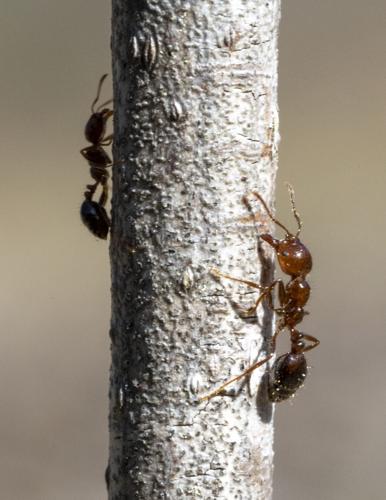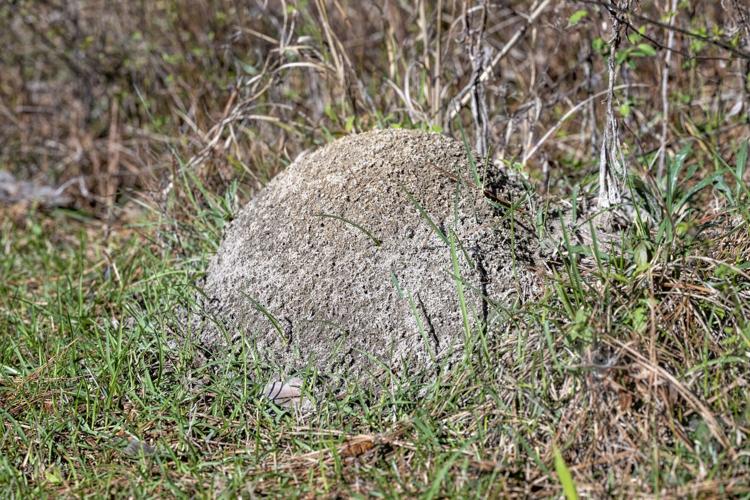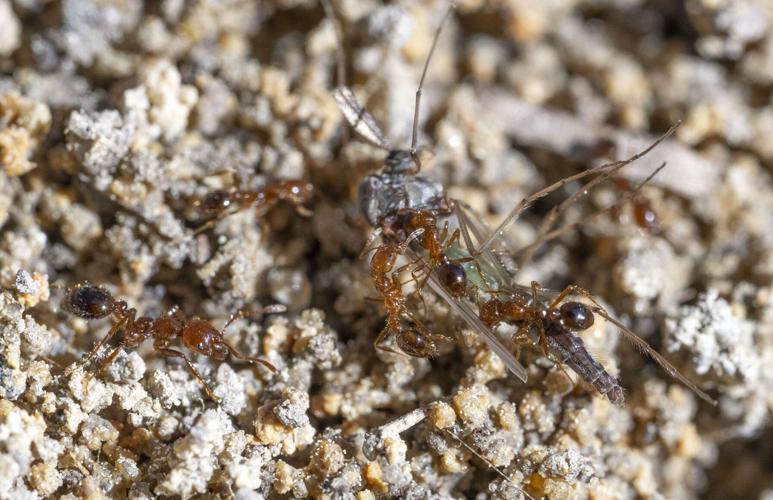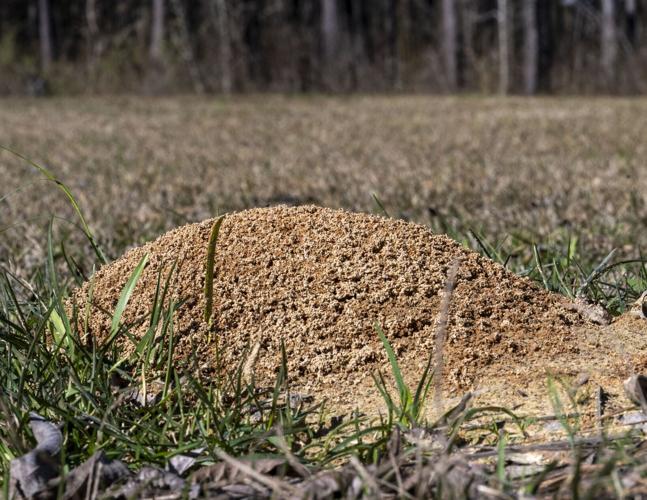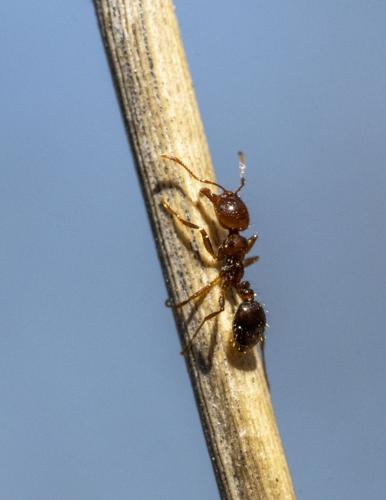Alabama was ground zero for the Red Imported Fire Ant invasion.
The plentiful, painful red ant is thought to have arrived from Brazil on a ship that landed in Mobile Bay in the late 1930s. It began a march that spread across the state and now blankets more than 350 million acres of the southern U.S. The Red Imported Fire Ant can now be found in Virginia, North Carolina, South Carolina, Georgia, Florida, Mississippi, Tennessee, Arkansas, Texas and Oklahoma. They are also marching on a separate front up the coast of California, where they are thought to have arrived by truck from the Southeast. These red pests are now found in areas of Australia, New Zealand, many Caribbean islands, Hong Kong, Malaysia, Singapore, Taiwan and China, all by hitchhiking along international trade routes.
E. O. Wilson, Alabama’s most famous biologist – a 46-year Harvard professor, the winner of two Pulitzer Prizes and a National Medal of Science recipient – was the first person to discover Red Imported Fire Ants in the U.S. He discovered them in a vacant lot in Mobile as a high school student.
There are two other Imported Fire Ants now living in Alabama. Like its cousin, the Black Imported Fire Ant also arrived from South America, sometime around 1918. It not as invasive or as problematic as the Red Imported Fire Ant, but the two have bred and produced the Hybrid Imported Fire Ant, which can also be found in Alabama.
There are many species of ants that evolved to live in the Lake Martin area, including several native fire ants, but Red Imported Fire Ants cause the bulk of ant problems here. That’s because when they hitched a ride from South America, their natural predators didn’t follow. So here in the Southeast, there are roughly five times as many fire ant mounds per acre as there are in South America.
Red Imported Fire Ants are known to scientists as Solenopsis invicta. The second word, Invicta, is derived from Latin, meaning “invincible” or “unconquered.” Anybody who has tried to keep fire ants out of an Alabama lawn knows it is a well-deserved name.
Most Alabamians who have mistakenly stepped on a fire ant bed know how aggressively these tiny insects attack. Their method of defense is to overwhelm anything that disturbs their mounds. In the blink of an eye, fire ants will swarm aggressively up out of their mound and climb anything nearby – grass, sticks, feet and legs. The worker ants that make up the bulk of every colony can sting repeatedly and painfully. Usually, by the time you feel one sting there are many – sometimes hundreds – of other ants already on your leg preparing to add to your severe discomfort.
Identifying fire ants can be difficult. The individual ants of a fire ant colony vary in size, from 1/8 to 1/4 of an inch. Both male and female fire ants can have wings, but most do not. They are red to dark reddish-brown in color, with darker abdomens. On the narrow segment between their bodies and large abdomens, there are two bumps or nodes. The abdomen of a red ant is black, and that of a black or hybrid ant is partially red.
The fire ant’s mound is also an identifier. It begins as only a few inches of fluffy, granulated soil, but can grow up to 2 feet tall and more than 18 inches in diameter with no opening in the center. The mound itself is made up of soil that the worker ants bring up to the surface as they tunnel underground. Tunnels extend in all directions away from the mound, with random tunnels sprouting up to the surface for foraging. These tunnels can stretch up to 300 feet long. Fire ants typically build their mounds in clear, sunny areas in almost any type of soil. As a result, you can tell what type of soil is beneath the surface by the color of the mound – red or yellow indicates clay; lighter colors indicate sandy soil; and gray indicates a deeper topsoil.
Fire ant stings are painful and cause both burning and itching sensations. When a fire ant attacks, it uses its mandibles to bite the flesh, and then injects venom with a stinger on the end of its abdomen. So, when people say they were bitten by a fire ant, they are technically correct. But the sting is what causes most of the irritation.
The red welt left from each sting often blisters and produces a pustule that can last for a week or more. For most people, fire ant stings are merely annoying. But for those few who are hypersensitive to the sting, they can be much worse. While rare, fire ant venom can cause an anaphylactic reaction in certain individuals that can result in chest pains, nausea, coma or even death. More than 80 people have died in the U.S. from fire ant stings, according to the National Library of Medicine.
The life cycle of a fire ant is complex and similar to that of honey bees. There are three sizes of workers: the minor workers live 30 to 60 days, the media workers live 60 to 90 days and the major workers can live anywhere from 90 to 180 days. The queen of a colony lives up to six years.
After a colony has been established for about a year, it produces hundreds or even thousands of alates, or winged males and females. These winged fire ants fly up into the sky to mate, usually after a rainy day when it is warm and sunny. The ants fly high – almost 400 feet for females and more than twice that for males. The males die after mating, but the young queens fly up to a mile before coming back to earth and clustering together to form a new colony. They use their legs to break off their wings and seek shelter under some sort of protective cover, such as the edge of a sidewalk or a rock or leaves. Within a day, the queen will lay 10 to 15 eggs, beginning a new colony. As the colony grows, usually all but the strongest queen is killed. Within six months, the colony will be thousands of ants strong.
The queen’s job is to lay eggs – up to 1,500 per day – while the workers forage food and build the mounds. A single colony can eventually contain as many as 240,000 ants, though most have fewer than 100,000. A colony with multiple queens can contain up to 400,000 ants.
Fire ants are omnivores and eat dead animals, like insects and worms, as well as honeydew from plants. The imported ants are strong competitors and can push many native ant species out of the area.
These ants can cause a number of problems for people, besides inflicting painful bites. They can harm pets, damage crops and cause structural problems under pavement and walls or potholes in roads. After a heavy rain, they may seek shelter in buildings. For that matter, these ants are known to join together by the thousands to form floating rafts in flooded areas, which can make walking through flooded water dangerous. Fire ants damage electric equipment by chewing through wiring insulation, causing shorts in electric motors, transformers, pumps, air conditioners and other equipment.
There is no easy way to eliminate fire ants without chemicals. Three gallons of boiling water poured into a fire ant mound will kill the colony about 60 percent of the time. There are a number of insecticides – both liquid and granules – that will kill a colony, but there is a good chance that fire ants will return as a nearby colony sends out newly mated queens.
Some information for this article came from the University of Florida Entomology & Nematology, University of Tennessee Institute of Agriculture, Oklahoma State University Extension, Texas A&M Agrilife, The National Library of Medicine, Orkin and The United States Department of Agriculture.

